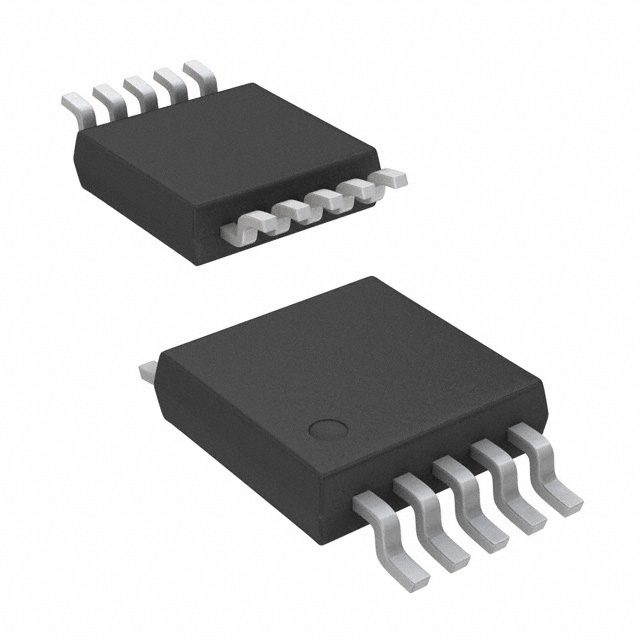Siehe Spezifikationen für Produktdetails.

AD7690BRMZ
Product Overview
- Category: Analog-to-Digital Converter (ADC)
- Use: Converts analog signals into digital data
- Characteristics: High resolution, low power consumption, small package size
- Package: 10-lead MSOP package
- Essence: Provides accurate and precise conversion of analog signals to digital format
- Packaging/Quantity: Available in reels of 2500 units
Specifications
- Resolution: 16 bits
- Sampling Rate: Up to 250 kSPS (thousand samples per second)
- Input Voltage Range: 0V to VREF
- Power Supply: 2.7V to 5.25V
- Operating Temperature Range: -40°C to +85°C
Pin Configuration
The AD7690BRMZ has the following pin configuration:
- VDD: Power supply voltage
- VREF: Reference voltage for ADC conversion
- AGND: Analog ground
- VIN: Analog input voltage
- SCLK: Serial clock input
- CS: Chip select input
- SDATA: Serial data output
- DGND: Digital ground
- RDY: Ready signal output
- NC: No connection
Functional Features
- High-resolution conversion with 16-bit accuracy
- Low power consumption for energy-efficient operation
- Small package size for space-constrained applications
- Serial interface for easy integration with microcontrollers or other digital systems
- Ready signal output for synchronization with external devices
Advantages and Disadvantages
Advantages: - High resolution ensures accurate conversion of analog signals - Low power consumption extends battery life in portable devices - Small package size allows for compact designs - Serial interface simplifies integration with digital systems
Disadvantages: - Limited input voltage range may not be suitable for high-voltage applications - Requires an external reference voltage (VREF) for accurate conversion
Working Principles
The AD7690BRMZ operates on the principle of successive approximation. It samples the analog input voltage and compares it to a reference voltage (VREF). The converter then generates a digital code that represents the input voltage with high precision. This digital code is outputted serially through the SDATA pin.
Detailed Application Field Plans
The AD7690BRMZ is commonly used in various applications, including:
- Industrial Automation: Measurement and control systems requiring high-precision analog-to-digital conversion.
- Medical Devices: Patient monitoring equipment that requires accurate measurement of physiological signals.
- Test and Measurement Instruments: Oscilloscopes, data loggers, and other instruments that need precise signal acquisition.
- Audio Equipment: High-fidelity audio systems that demand accurate digitization of analog audio signals.
- Power Monitoring: Energy management systems that monitor power consumption with high accuracy.
Detailed Alternative Models
Here are some alternative models that offer similar functionality:
- AD7680BRMZ: 16-bit ADC with lower power consumption but slightly lower sampling rate.
- AD7691BRMZ: 18-bit ADC with higher resolution but larger package size.
- AD7980BRMZ: 16-bit ADC with higher sampling rate but higher power consumption.
These alternatives can be considered based on specific application requirements and trade-offs between resolution, power consumption, and package size.
Word count: 346 words
Listen Sie 10 häufige Fragen und Antworten im Zusammenhang mit der Anwendung von AD7690BRMZ in technischen Lösungen auf
Sure! Here are 10 common questions and answers related to the application of AD7690BRMZ in technical solutions:
Q: What is the AD7690BRMZ? A: The AD7690BRMZ is a high-resolution, low-power, successive approximation analog-to-digital converter (ADC) manufactured by Analog Devices.
Q: What is the resolution of the AD7690BRMZ? A: The AD7690BRMZ has a resolution of 16 bits, allowing it to convert analog signals into digital values with high precision.
Q: What is the operating voltage range of the AD7690BRMZ? A: The AD7690BRMZ operates from a single power supply voltage ranging from 2.7V to 5.25V.
Q: What is the maximum sampling rate of the AD7690BRMZ? A: The AD7690BRMZ has a maximum sampling rate of 250 kilosamples per second (ksps), making it suitable for applications requiring fast data acquisition.
Q: Does the AD7690BRMZ support differential inputs? A: Yes, the AD7690BRMZ supports both single-ended and differential input configurations, providing flexibility in various measurement scenarios.
Q: What is the typical power consumption of the AD7690BRMZ? A: The AD7690BRMZ has a typical power consumption of 1.5 milliwatts (mW) during normal operation, making it suitable for low-power applications.
Q: Can the AD7690BRMZ operate in a temperature range outside the commercial range? A: Yes, the AD7690BRMZ can operate in an extended industrial temperature range of -40°C to +105°C, making it suitable for harsh environments.
Q: Does the AD7690BRMZ provide any built-in reference voltage? A: No, the AD7690BRMZ requires an external reference voltage for accurate conversions. However, it does offer a flexible reference input range.
Q: What is the interface used to communicate with the AD7690BRMZ? A: The AD7690BRMZ uses a serial peripheral interface (SPI) for communication with microcontrollers or other digital devices.
Q: Can multiple AD7690BRMZ ADCs be cascaded together? A: Yes, multiple AD7690BRMZ ADCs can be cascaded together using the daisy-chain feature, allowing for simultaneous conversion of multiple channels.
I hope these questions and answers help! Let me know if you have any more specific queries.

